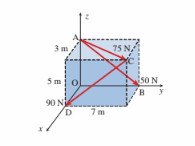What elements do the symbols H, O, C, and N stand for?
a. hydrogen, ozone, carbon, nitrogen
b. hydrogen, oxygen, chlorine, nitrogen
c. hydrogen, oxygen, carbon, natrium
d. hydrogen, oxygen, carbon, nitrogen
e. none of the above
d
You might also like to view...
An object is thrown upwards with a speed of 14 m/s. How high above the projection point does it reach?
A) 5.0 m B) 10 m C) 15 m D) 20 m E) 25 m
What of the following distance methods is used to determine the distance to the most distant galaxies?
a. radar echo b. supernova observations c. period-luminosity relationship of variable stars d. parallax
The resultant force R (in newtons) for the force system shown in the figure is:
(A) 29.5i 1 36.4j – 81.4k
(B) 229.5i – 36.4j 1 78.3k
(C) 236.4i 1 29.5j 1 81.4k
(D) 239.3i 1 36.4j 1 122.2k

You conduct the following three ball drops, in each case measuring the time it takes for the ball to fall to the ground; the mass is the mass of the ball and the height is the height from which you drop the ball:
Ball Drop 1. Mass 0.5 kilograms, height 20 meters Ball Drop 2. Mass 5.0 kilograms, height 20 meters Ball Drop 3. Mass 0.5 kilograms, height 30 meters Which pair of ball-drops will best test whether mass affects the acceleration of gravity? A) ball drops 2 and 3 B) ball drops 1 and 3 C) ball drops 1 and 2